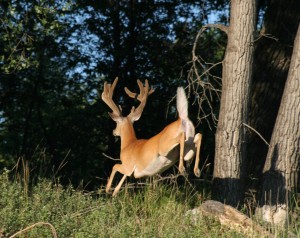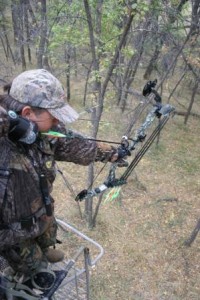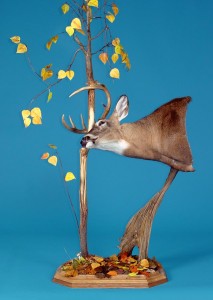 Here are some questions I got from BIG DEER TV viewers, with hopes that the answers will help you shoot a buck this fall.
Here are some questions I got from BIG DEER TV viewers, with hopes that the answers will help you shoot a buck this fall.
Mike: It was warm where I hunt all last fall, with temperatures in the 60s and 70s some days. We saw fewer deer than normal each day and hardly any of them came to our corn fields, even though there were few acorns in the woods. Weird, tough season! What can we do if it’s warm again this fall? Paul
Paul: Hunting in heat is the new norm in many places, and I get a ton of questions about it. .
As to why you had fewer deer coming to your cornfields, get this. Missouri biologist Grant Woods points out that during an extended stretch of unusually warm fall or winter weather, deer prefer to feed on green forage (weeds, browse, etc.) and forgo corn or even soybeans, since the grains are rich in carbohydrates and digesting them generates more body heat that the animals don’t want or need when it’s hot.
Strategy-wise, move your stands off grain fields, and set up back in the woods near green thickets and other browse areas where does and bucks will forage both morning and afternoon. Set some stands in creek bottoms and other cool, shady funnels leading to or from the browse.
Mike: I’ve heard that a buck can learn you are hunting him, and move around to avoid your stands. Do you think that’s true? Joe, Arkansas
Joe: I don’t believe a mature buck can reason that you are in the woods, hunting him and trying to kill him. But he most certainly feels your presence and disturbance, perceives you as a threat and tries to avoid you at all costs.
New science backs that up. Tracking and charting 37 GPS-collared adult bucks over three years in South Carolina, researchers found that late in hunting season, the bucks moved an average of 55 yards farther away from tree stands than they did earlier in the fall. The big deer had seen, smelled and sensed humans in and around those stands over the weeks, and had skirted them right out of bow range.
When you’re hunting a big buck in his small core range, don’t over-hunt your best stands, but rest them for days. Once in a while, move a stand 50 to 100 yards where the wind is right (a climber works great) or set up for a quick ground ambush. Try to surprise a buck from a new spot where he doesn’t expect you to be, as I have said many times on TV.
How high do you hang a tree stand? Pat, New York
Over the years, I’ve experimented with stands from 15 to 30 feet (I don’t like any stand that is too high and don’t recommend it) and have now settled on 17 or 18 as just right for me. This is high enough where the wind is good, and if you move skillfully, deer won’t look up and see you. At this height, you have a good sight plane down and out to a buck’s vitals for a shot.
Mike: Most every time I sneak into my tree stand I jump a couple of deer. What am I doing wrong? Travis, Tennessee
Travis: You are accessing your stand from a wrong direction, most likely walking too close to a bedding or staging area. Check your maps and chart a different route in. Put the wind in your face or move in a cross wind as you sneak in a new way, and use foliage and terrain (deep creek, hogback ridge, etc) to cover your moves. Get to your stand without bumping deer and your odds of seeing a shooter buck later in the day or next week go way up.
I was surprised to read in Outdoor Life one time that you pee off your tree stand. Is that right? Rob, MD
Rob: Years ago, I used to carry and use a pee bottle, but now I look around to make sure no deer are coming (I don’t want them to see or hear me) and let fly right off my stand. Urine is 95% water. Many deer scientists that I read and respect, including James Kroll and Grant Woods, have deduced from their studies that human urine does not spook deer, and in fact may attract a curious animal on occasion. So I say go ahead and pee when you have to. I should note that many great hunters and scent freaks that I know totally disagree and would never do it.
Mike: Is it true that once a buck sheds his velvet, he’s ready to breed does? Jacob, Oklahoma
Bucks typically peel the velvet from their antlers the last week of August or the first week of September. Older bucks often shed the velvet a few days earlier than younger bucks. The day a mature buck becomes “hard horn” his demeanor begins to change, he gets more aggressive by the day and yes, he is ready, willing and able to breed a doe. But in reality he won’t get that opportunity until mid-October, when a few odd does come into an early estrus cycle, and most likely he’ll get his first shot sometime in November.
I’ve noticed some large trees in my area that have obviously been rubbed by generations of bucks over the years. What’s up with those rubs? Dave, Montana
Trees with old scars that have healed and thickened, and upon which more bucks rub their antlers each fall, are “sign-posts.” Biologists point out that these trees are rubbed mostly by older bucks (3½ years and up). One theory is that the older bucks deposit pheromones on the rubs, and this plays an important role in the dominance and subordination process in a herd. Does and all size or bucks have been observed interacting with sign-posts—they often nuzzle and smell them—but only older bucks rub them hard. Sign-posts are blazed in areas with high deer traffic, and should be markers for your strategy. While you won’t hunt over a sign-post per se, it makes sense to scout out from the big rubs, look for nearby cover edges, funnels and trails where bucks travel, and hang tree stands there.











